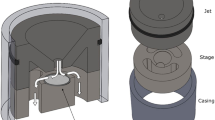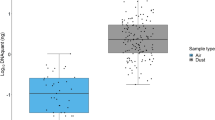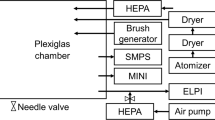Abstract
Environmental forensic microscopy investigations are based on the methods and procedures developed in the fields of criminal forensics, industrial hygiene and environmental monitoring. Using a variety of microscopes and techniques, the environmental forensic scientist attempts to reconstruct the sources and the extent of exposure based on the physical evidence left behind after particles are exchanged between an individual and the environments he or she passes through. This article describes how environmental forensic microscopy uses procedures developed for environmental monitoring, criminal forensics and industrial hygiene investigations. It provides key references to the interdisciplinary approach used in microscopic investigations. Case studies dealing with lead, asbestos, glass fibers and other particulate contaminants are used to illustrate how environmental forensic microscopy can be very useful in the initial stages of a variety of environmental exposure characterization efforts to eliminate some agents of concern and to narrow the field of possible sources of exposure.
This is a preview of subscription content, access via your institution
Access options
Subscribe to this journal
Receive 6 print issues and online access
$259.00 per year
only $43.17 per issue
Buy this article
- Purchase on Springer Link
- Instant access to full article PDF
Prices may be subject to local taxes which are calculated during checkout









Similar content being viewed by others
References
Abraham J.L. Documentation of environmental particulate exposures in humans using SEM and EDXA. In: Johari O. (Ed.) Scanning Electron Microscopy, 1979, II. Scanning Electron Microscopy Inc., Chicago, 1979, pp. 751–766.
Abraham J.L., Hunt A., and Burnett B.R. Steel particles as a marker of welding fume exposure, frequency of occurrence and prevalence of steel particles in a series of over 400 human lungs. Ann Occup Hyg 1999: 38 (Suppl. 1): 551–557.
Abraham J.L., Hunt A., and Burnett B.R. Quantification of non-fibrous and fibrous particulates in human lungs: twenty year update on pneumoconiosis database. Ann Occup Hyg 2002: 46 (Suppl. 1): 397–401.
ASTM. Standard Practice D6602-03b, Sampling Testing of Possible Carbon Black Fugitive Emissions or Other Environmental Particulate, or Both. American Society for Testing Materials International, West Conshohocken, PA, 2003.
Brown R.S., Millette J.R., and Mount M.D. Application of scanning electron microscopy for pollution particle source determination in residential dust and soil. Scanning 1995: 17 (5): 302–305.
Chisum J.W., and Turvey B.E. Evidence dynamics: Locard's Exchange Principle & crime reconstruction. J Behavioral Profiling 2000: 1 (1): 25–38.
Dodson R.F., and Atkinson M.A.L. Measurements of asbestos burden in tissues — identifying and preventing hazards in the environment and at work. Ann NY Acad Sci 2006: 1076: 281–291.
Few P., and Millette J.R. A combination calibration grid for transmission electron microscopes. Microscope 1996: 44 (4): 175–179.
Fireman E.M., Greif J., Schwarz Y., Man A., Ganor E., Ribak Y., and Lerman Y. Assessment of hazardous dust exposure by BAL and induced sputum. Chest 1999: 11: 1720–1728.
Fireman E.M., Lerman Y., Ganor E., Greif J., Fireman-Shoresh S., Lioy P.J., Banauch G.I., Weiden M., Kelly K.J., and Prezant D.J. Induced sputum assessment in New York City firefighters exposed to World Trade Center dust. Environ Health Perspect 2004: 112: 1564–1569.
Ghazi A.M., and Millette J.R. Environmental forensic application of lead isotope ratio determination: a case study using laser ablation sector ICP-MS. Environmental Forensics 2004: 5 (2): 97–108.
Graves W.J. A mineralogical soil classification technique for the forensic scientist. J Forensic Sci 1979: 24: 323–338.
Hopen T.J. The value of soil evidence. In: Houck M.M. (Ed.). Trace Evidence Analysis. Elsevier Academic Press, Boston, 2004, pp. 105–122.
Hunt A., Hawkins J., Gilligan E., and Bhatiab S. A comparison of the lead particle content of indoor dust before and after a lead paint abatement: a new source of lead recontamination. Indoor Built Environ 1998: 7: 32–46.
Hunt A., Johnson D.L., and Thornton I. Descriptive apportionment of lead in house dust by automated SEM. Water Air Soil Pollut 1991: 57–58: 69–77.
Hunt A., Johnson D.L., Watt J.M., and Thornton I. Characterizing the sources of particulate lead in house dust by automated scanning electron microscopy. Environ Sci Technol 1992: 26 (8): 1513–1526.
Hyung H., Fortner J.D., Hughes J.B., and Kim J. Natural organic matter stabilizes carbon nanotubes in the aqueous phase. Environ Sci Technol 2007: 41 (1): 179–184.
Kelley M., Watson P., Thorton D., and Halpin T.J. Lead intoxication associated with chewing plastic wire coating. MMWR Morb Mortal Wkly Rep 1993: 42: 465–467.
Krumbein W.C., and Pettijohn F.J. Manual of Sedimentary Petrography. Appelton-Century-Crofts, New York, 1938.
Lioy P.J. Employing dynamical and chemical processes for contaminant mixtures outdoors to the indoor environment: the implications for total human exposure analysis and prevention. J Expos Analysis and Environ Epi 2006: 16: 207–224.
Lioy P.J., Freeman N.C., and Millette J.R. Dust: a metric for use in residential and building exposure assessment and source characterization. Environ Health Perspect 2002a: 110 (1): 969–983.
Lioy P.J., Weisel C.P., Millette J.R., Eisenreich S., Vallero D., Offenberg J., Buckley B., Turpin B., Zhong M., Cohen M.D., Prophete C., Yang I., Stiles R., Chee G., Johnson W., Porcja R., Alimokhtari S., Hale R.C., Weschler C., and Chen L.C. Characterization of the dust/smoke aerosol that settled east of the World Trade Center (WTC) in Lower Manhattan after the collapse of the WTC 11 September 2001. Environ Health Perspect 2002b: 110 (7): 703–714.
Locard E. The analysis of dust traces. Part II. Am J Police Sci 1930: 1: 401–418.
Malderen H., Van Grieken R., Bufetov N.V., and Koutzenogii K.P. Chemical characterization of individual aerosol particles in central Siberia. Environ Sci Technol 1995: 30 (1): 312–321.
Maynard A.D., Aitken R.J., Butz T., Colvin V., Donaldson K., Oberdörster G., Philbert M.A., Ryan J., Seaton A., Stone V., Tinkle S., Tran L., Walker N.J., and Warheit D.B. Safe handling of nanotechnology. Nature 2006: 444: 267–269.
McCrone W.C. Forensic soil examination. Microscope 1992: 40: 109–121.
McCrone W.C., and Delly J.G. The Particle Atlas. Ann Arbor Science Publishers Inc., Ann Arbor, 1972.
Millette J.R., and Bandli B.R. Asbestos identification using available standard methods. Microscope 2005: 53 (4): 179–185.
Millette J.R., Boltin R., Few P., and Turner Jr W. Microscopical studies of World Trade Center disaster dust particles. Microscope 2002: 50 (1): 29–35.
Millette J.R., Brown R.S., Barnett J., and Mount M.D. Scanning electron microscopy of post-it notes used for environmental sampling. NAC Journal 1991: 1: 32–35.
Millette J.R., Brown R.S., and Mount M.D. Lead arsenate. Microscope 1995: 43 (4): 187–191.
Millette J.R., Brown R.S., Turner Jr W., and Few P. Zinc whiskers in computer facility dust. Microscope 2004: 52 (2): 59–62.
Millette J.R., and Few P. Sample collection procedures for microscopical examination of particulate surface contaminants. Microscope 2001: 49 (1): 21–27.
Millette J.R., Hopen T.J., and Brown R.S. Investigating the particulate component in indoor air quality concerns. Environmental Choices 1994: 3 (2): 14–16.
Millette J.R., Lioy P.J., Wietfeldt J., Hopen T.J., Gipp M., Padden T., Singsank C., and Lepow J. A microscopical study of the general composition of household dirt. Microscope 2003: 51 (4): 201–207.
Murray R.C. Evidence From the Earth, Forensic Geology and Criminal Investigation. Mountain Press Publishing Co., Missoula, MT, 2004.
Oberdorster G., Oberdorster E., and Oberdorster J. Nanotoxicology: an emerging discipline evolving from studies of ultrafine particles. Environ Health Perspect 2005: 113: 823–839.
Palenik S.J. The determination of geographical origin of dust samples. In: McCrone W.C., Delly J.G., Palenick S.J. (Eds.). The Particle Atlas, 2nd edn. Vol 5, Ann Arbor Science Publishers Inc., Ann Arbor, 1979 pp. 1347–1361.
Palenik S.J. Microscopy and microchemistry of physical evidence. In: Saferstein R. (Ed.). Forensic Science Handbook, Vol 2, Prentice Hall, Englewood Cliffs, NJ, 1988 pp. 161–208.
Petraco N., and Kubic T. Color Atlas, Manual of Microscopy for Criminalists, Chemists, and Conservators. CRC Press, New York, 2003.
Pirrie D., Power M.R., Rollinson G., Camm G.S., Hughes S.H., Butcher A.R., and Hughes P. The spatial distribution and source of arsenic, copper, tin and zinc within the surface sediments of the Fal Estuary, Cornwall, UK. Sedimentology 2003: 50 (3): 579–595.
Rybicka E.H., Wilson M.J., and McHardy W.J. Chemical and mineralogical forms and mobilization of copper and lead in soils from a Cu-smelting area in Poland. J Environ Sci Health 1994: Part A A29 (3): 531–546.
Saferstein R. Criminalistics: An Introduction to Forensic Science. 5th edn. Prentice Hall, Englewood Cliffs, NJ, 1995.
Saferstein R. Criminalistics: An Introduction to Forensic Science. 9th edn. Prentice Hall, Englewood Cliffs, NJ, 2006.
Thornton I., Watt J.M., Davies D.J.A., Hunt A., Cotter-Howells J., and Johnson D.L. Lead contamination of UK dusts and soils and implications for childhood exposure: an overview of the work of the Environmental Geochemistry Research Group, Imperial College, London, England 1981–1992. Environ Geochem Health 1994: 16: 113–122.
Turner W.L., Millette J.R., Boltin W.R., and Hopen T.J. A standard approach to the characterization of common indoor dust constituents. Microscope 2005: 53 (4): 169–177.
United States Environmental Protection Agency (USEPA). Final Report on the World Trade Center (WTC) Dust Screening Method Study. U.S. Environmental Protection Agency, Washington, DC, 17 August, 2005.
Yiin L-M., Millette J.R., Vette A., Ilacqua V., Quan C., Gorczynski J., Kendall M., Chen L.C., Weisel C.P., Buckley B., Yang I., and Lioy P.J. Comparisons of the dust/smoke particulate that settled inside the surrounding buildings and outside on the streets of southern New York City after the collapse of the World Trade Center, September 11, 2001. J Air Waste Manage Assoc 2004: 54: 515–528.
Acknowledgements
We thank Frank Bull, the Atlanta architect, for his questions in 1986 concerning the source of asbestos fibers in dusts that initiated a number of studies that lead to the development of environmental forensic microscopy procedures in our laboratory for all types of environmental particulates.
Author information
Authors and Affiliations
Corresponding author
Rights and permissions
About this article
Cite this article
Millette, J., Brown, R. & Hill, W. Using environmental forensic microscopy in exposure science. J Expo Sci Environ Epidemiol 18, 20–30 (2008). https://doi.org/10.1038/sj.jes.7500613
Received:
Accepted:
Published:
Issue Date:
DOI: https://doi.org/10.1038/sj.jes.7500613



